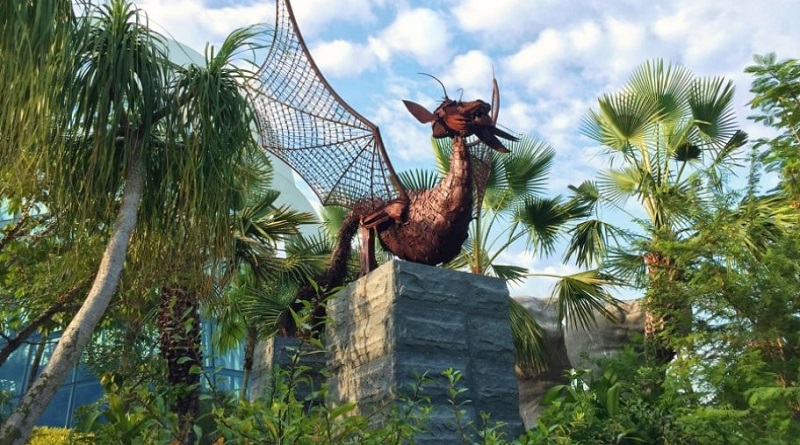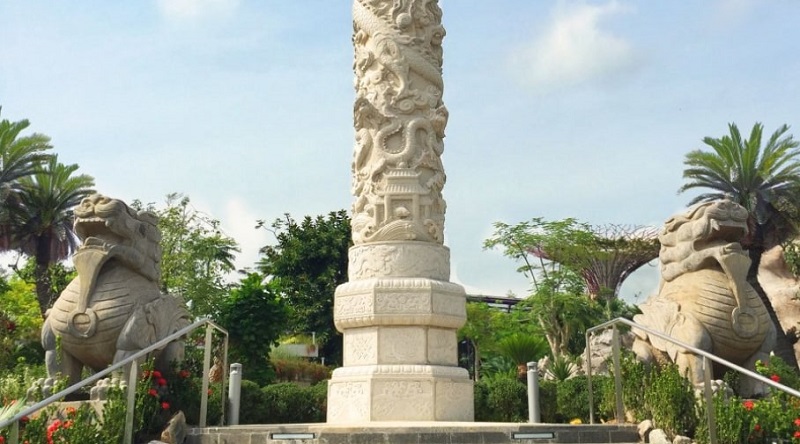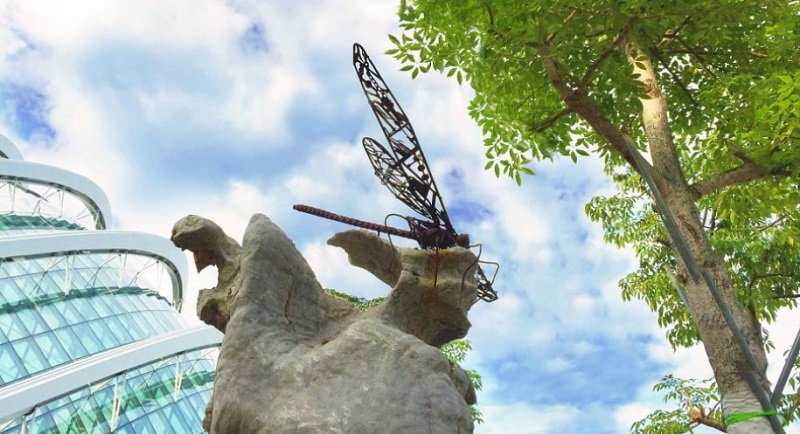Nature, art, and culture meet along a 400-meter-long trail at The Canyon in Gardens by the Bay. Every step reveals sculptural rocks shaped by centuries, rare desert plants with fascinating forms, and carefully placed metal monuments that carry deep symbolic meaning.
Visitors do not find an ordinary garden path. They enter a curated landscape where ancient Chinese stones stand tall near Australian grass trees and Brazilian flowering trees. Each element contributes to a layered outdoor gallery filled with colors, textures, and stories.
Jun-ichi Inada, a renowned landscape architect, shaped The Canyon with a clear purpose. He transformed imported boulders and exotic flora into a dramatic open-air installation unlike anything else in Singapore. Admission is free. The experience feels priceless.
Sculptural Rocks That Speak Through Shape and Age
Every rock in The Canyon has a story. Over 60 sculptural stones were sourced directly from Shandong, China. Each one formed through centuries of geological pressure, erosion, and weather shifts. The result is a diverse set of rock structures that resemble animals, waves, thrones, and mythic figures. No two are alike. Their raw, natural shapes reveal the silent work of time.

The Canyon features the largest outdoor collection of such stones in Singapore. The decision to use rocks from Shandong was not random. That region is known for its limestone mountains and rich rock heritage, often linked to Chinese classical gardens. By relocating them to Singapore, Jun-ichi Inada brought a piece of that history into a new cultural and botanical context.
A Trail That Mimics a Dragon
The layout of the 400-meter trail draws inspiration from Chinese mythology. It curves and stretches across the landscape like a dragon in motion. Visitors walking along the path find themselves guided by the flow of this symbolic shape. This layout gives the trail movement, energy, and meaning.
Each stone is placed intentionally. Some stand upright like guards. Others sprawl sideways like sleeping giants. The positioning creates a rhythm that turns a simple walk into a visual journey. The placement encourages reflection, pause, and observation.
Contrast With the Urban Backdrop
The sculptural rocks stand out sharply against the backdrop of the Cooled Conservatories and Marina Bay skyline. The natural textures of stone contrast with the glass domes and city buildings. This visual tension enhances the beauty of each element.
At sunrise and sunset, the rocks glow with shifting colors. Their surfaces reflect golden light in the morning and soft pastels in the evening. Photographers, artists, and casual visitors often find inspiration in how the light changes the entire scene throughout the day.
Rare Plants That Thrive Where Few Others Can
The Canyon hosts over 200 plant species, all carefully selected for their ability to survive in harsh, dry climates. These species originate from deserts, savannahs, and bushlands around the globe. They introduce new textures and colors to Singapore’s tropical scenery.

Visitors encounter silver foliage, thick trunks, sharp spines, and strange growth forms. Every plant serves both a
n aesthetic and educational purpose.
Highlighted Species
- Beaked Yucca (Yucca rostrata)
Its powder-blue leaves fan out like fireworks. A tall central stalk rises above the foliage, bearing cream-white blooms that resemble beaks. - Doum Palm (Hyphaene thebaica)
This palm’s forked trunk forms a Y-shape, unlike most palms. Tribes along the Nile and Niger Rivers use its leaves for weaving ropes, baskets, and mats. - Cockspur Coral Tree (Erythrina crista-galli)
Its bright red flowers and nitrogen-fixing roots help restore poor soil. The sharp floral keels resemble a rooster’s spur, giving it its name.
Beauty and Adaptation
Many of the plants on display serve a greater purpose in their native ecosystems. The Grass Tree (Xanthorrhoea glauca) survives bushfires with a charred trunk and regenerates rapidly. Moore’s Cycad (Macrozamia moorei) grows slowly but can live for centuries. These plants are not only ornamental. They show how life adapts, recovers, and flourishes in tough conditions.
Their forms surprise many visitors. Some resemble sculptures. Others appear prehistoric.
Plant Rarity and Conservation Significance
The Yellow Rain Tree (Albizia saman ‘Yellow’) offers a lesson in rarity. Caused by a recessive genetic mutation, this golden-leaved cultivar appears only once in every thousand seeds. Seeing one is unusual. The presence of such rare plants reminds guests that botanical conservation depends on visibility and awareness.
Likewise, Pochote (Ceiba schottii) uses its stout spines and fragrant flowers to defend itself and attract pollinators.
Sculptures That Add Story and Symbolism
1. Marco Drago: A Dragon’s Journey

At the heart of The Canyon stands a large metal dragon named Marco Drago. Sculptor Simone Belotti designed it based on an original story by Mr John Koh. According to the tale, Marco Drago traveled east in search of peace and beauty, eventually resting among the stones of Gardens by the Bay.
The sculpture, made from dark metal, twists through the landscape with a sense of movement and strength. It becomes a focal point for both children and adults. The dragon brings fantasy into a space shaped by geology and botany.
2. Huabiao Totems: Columns of Authority

Two towering granite columns rise near the edge of Marina Bay. These are modern versions of Huabiao, ancient Chinese architectural markers used to signal direction or announce imperial authority. Each column features a coiled dragon motif that wraps around the stone.
One stands at an impressive height of 10 meters. The presence of these totems links The Canyon to historical traditions and reflects the influence of East Asian design throughout the trail. Their size, placement, and symbolism add gravity to the garden.
3. Dragonfly: A Sign of Health and Harmony

The giant dragonfly sculpture, also crafted by Simone Belotti, uses salvaged metal and represents ecological balance. Dragonflies are drawn to healthy, thriving environments. In The Canyon, the sculpture becomes a visual reminder of the Gardens’ sustainability efforts.
It perches gracefully near the trail, reflecting sunlight off its sleek wings. Donated by Ms Juanita Foo, it also reflects how artistic contributions help shape public spaces.
Why The Canyon Deserves a Visit
The Canyon at Gardens by the Bay combines ancient rock forms, desert plants, symbolic sculptures, and sweeping views into one unified trail. Each section offers something rare. Together, they tell a story about endurance, creativity, and connection.
No admission fee. No time limit. No ordinary path. Visitors return again and again, drawn by the quiet drama of stone and leaf, light and sky. The Canyon does not compete with other gardens. It exists in a category of its own.
For anyone seeking wonder, reflection, or inspiration, The Canyon offers all three. Come during sunrise. Come after sunset. Each time will offer something new. Each visit will leave something behind.

